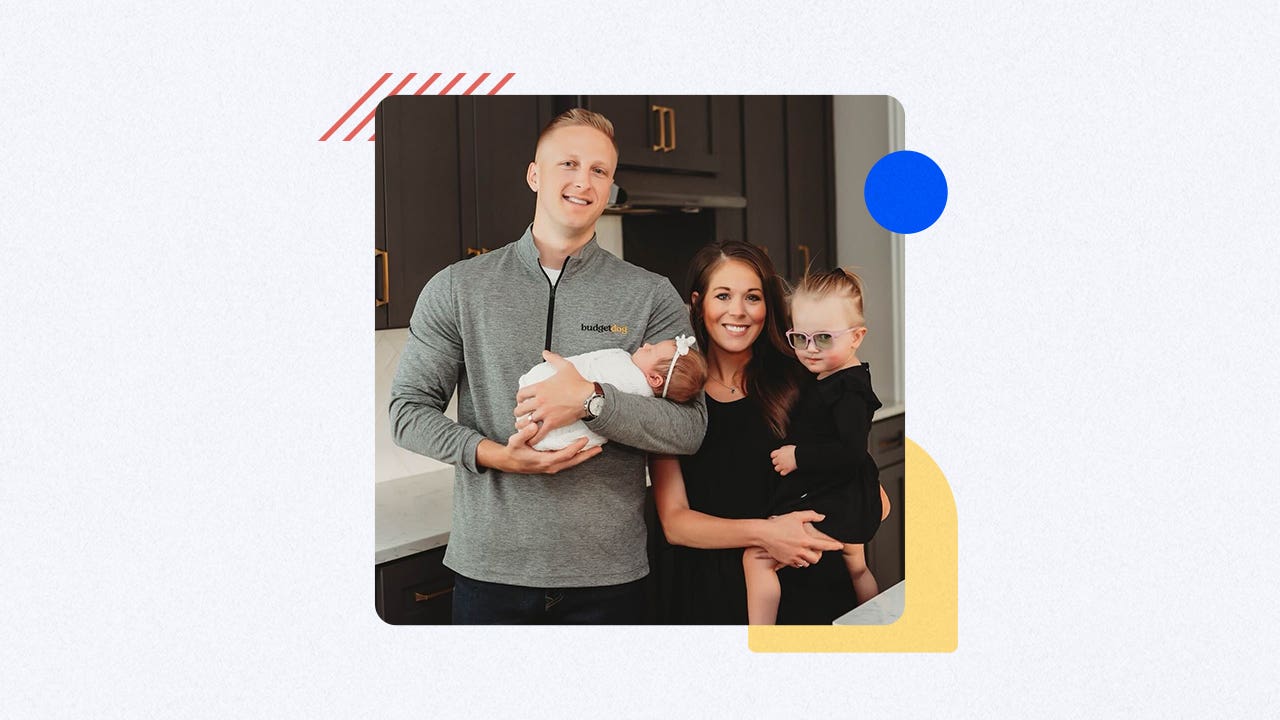This CPA dad opened these investment accounts for his babies to amass millions — here’s how you can, too

The Bankrate promise
At Bankrate we strive to help you make smarter financial decisions. While we adhere to strict , this post may contain references to products from our partners. Here's an explanation for .
They say it’s never too early to start investing. Brennan Schlagbaum, a certified public accountant, took that to heart. He opened an investment account for his two-year-old daughter, Logan, before she was even born.
Schlagbaum — better known as “BudgetDog” to his hundreds of thousands of followers on Instagram and X (formerly Twitter) — posted a thread on his Instagram in March about how he’s growing wealth for his daughter while she’s still in diapers.
Schlagbaum and his wife, Erin, have opened three different accounts for Logan: a 529 plan, a taxable brokerage account and a custodial Roth IRA.
“With these contributions alone, [Logan will] hit a whopping $3,184,873 by [age] 50,” Schlagbaum wrote in his post. “That’s assuming an 8 percent return. If she waits until 65 — $10,102,958.”
Schlagbaum, 31, says he first heard about investing for babies when he was 25 years old and working as an auditor at a business consulting company.
“Once I started learning about it, I realized this was such an obvious go,” says Schlagbaum, who now lives with his family in Arlington, Texas. “When we had a kid at 30, I told my wife, ‘We’re definitely doing this.’”
Now, the Schlagbaums are following the same investment strategy for their newborn daughter, Ellie.
“These children are going to be so far ahead,” says Schlagbaum.
Working with a financial advisor can help you navigate the nuance of investing for your baby, from picking college savings plans to setting up a Roth IRA.
Here’s how the couple is setting up their daughters for financial success — and how you can do the same for your children, too.
Contribute $250 a month to a 529 plan
The Schlagbaums contribute $250 per month to a 529 plan, a tax-advantaged account used to help pay for educational expenses. Parents (or any other adult) can open the account and fund it on behalf of the child.
Account contributions grow tax-deferred, meaning you don’t pay taxes on the money up front. Money can be withdrawn tax-free so long as it’s used for qualified education expenses, covering a wide range from college costs like tuition, books and even a computer, to K-12 private school tuition.

And thanks to the SECURE Act 2.0, any unused money in a 529 plan, that’s been open for at least 15 years, can be rolled over into a Roth IRA for the beneficiary. That provision, which begins in 2024, allows for up to a $35,000 lifetime rollover.
“There’s a huge benefit to that,” says Schlagbaum. “If you overpay for school, you don’t have to worry anymore. You still have an alternative to funnel into.”
Navigating ever-changing tax rules isn’t easy, so working with an expert could be beneficial. A financial advisor can help you compare 529 plans in your state and guide you through investment options.
Contribute $250 a month to your own brokerage account
The Schlagbaums also kick in $250 a month to a taxable brokerage account. They opened accounts for the benefit of Logan and Ellie before they were even born.
These aren’t custodial accounts: They are set up under the parents’ names, not Logan or Ellie’s. They invest in low-cost index funds and exchange-traded funds, or ETFs.
“We’ll gift it to [them] at a later date,” says Schlagbaum. “But we get to choose when and how much. We retain control. It’s our investment.”
He points to the gift tax code, which in 2023, lets one person gift another person up to $17,000 per year — with no tax implications for either party.
The Schlagbaums would be subject to the capital gains tax if they sell investments inside the brokerage account before transferring funds to their daughters.
This can be a good strategy, but consider consulting with a financial advisor first. A professional can help you navigate the tax implications of gifting assets as well as selling investments in the brokerage account, when the time comes.
Schlagbaum suggests setting up taxable brokerage accounts for each child, separate from your own, to avoid confusion.
“We know the purpose of that account is just for [them],” he says. “So whatever that balance ends up being is technically [their] balance.”
Why they didn’t choose a UTMA or UGMA account
There’s a different type of investment account parents can open for their kids — a custodial brokerage account, also known as a UTMA or UGMA account. But Brennan says they’re not his first choice.
With these accounts, investment assets are managed for the child until he or she reaches majority — between ages 18 and 21, depending on the state. The parent loses control of the account once the child becomes an adult.
And unlike a 529 plan, UTMA or UGMA funds can be used for any purpose, meaning they aren’t earmarked exclusively for education.
Because they’re held in the name of the child, UTMA/UGMA accounts can hurt financial aid eligibility more than 529 plans or assets owned by parents.
“There’s a 20 percent impact to financial aid with that type of account,” he says. “So let’s say your child has $20,000 in there. It would reduce their need for financial aid by $4,000. Compare that with a 529, which is a 5.64 percent reduction.”
Pay your baby for work
Some teenagers have jobs. But do you know any toddlers receiving a 1099?
Schlagbaum’s last piece of advice may sound far-fetched but it’s perfectly legal thanks to an account called a custodial Roth IRA.
An adult (usually a parent) can set up a custodial Roth IRA on behalf of a minor, and the minor becomes the sole owner of the account once they reach legal adulthood. These accounts also offer the child flexibility for tax-free withdrawals later in life.
To qualify for a custodial Roth IRA, your child needs to earn wages from a job — and pay taxes on that income — whether that’s a babysitting gig or working at the grocery store.
To make it work for Logan — who obviously wasn’t employed as a newborn — Schlagbaum lists her through his company. He pays her $50 an hour for baby modeling.
By using a custodial Roth IRA, Schlagbaum can funnel up to the legal 2024 IRA contribution limit of $7,000 per year to each working child. They’re not earning the full contribution amount now, but Brennan says the goal is to boost his daughters’ wages once they turn seven years old.

“They’re putting it directly into a tax-free vehicle, and they’ll have a lot of compounding growth with time,” he says.
To make everything legitimate (and legal), the work the child performs must be ordinary and necessary for the business. “You can’t just pay your kid to do whatever at way above market rate, or that could get flagged [by the IRS],” says Schlagbaum.
In order to do it, the Schlagbaums had to create separate checking accounts for their daughters. They also established a trust, a complex legal structure used to transfer assets.
“A trust makes sense once you add dependents and complexity to your situation,” says Schlagbaum. “There will be stipulations we have in place in conjunction with the trust.”
Any dependent earning less than $13,850 in 2023 isn’t required to pay federal income taxes. But your child would be subject to self-employment taxes if you assign them a 1099 employee tax status.
“If it’s a side hustle, the child would just have a Schedule C and be a 1099 independent contractor,” he says.
Schlagbaum also created a tracker to note every time his children get paid by the company, the amount and for what type of work.
“I also have an audit trail,” he added.
Schlagbaum acknowledges that the average person should consult a financial advisor or a CPA to set up this sort of custodial Roth IRA arrangement.
“Just to be safe,” he says. “You’ll never guess your way through this stuff.”
Why invest for your children?
It’s no secret that wealth builds over time. More time in the market means more time for investment gains to compound and grow.
“With over 20 years of compounding interest, it doesn’t take a whole lot to get extremely wealthy,” says Schlagbaum.
Need expert guidance when it comes to managing your investments or planning for retirement?
Bankrate’s AdvisorMatch can connect you to a CFP® professional to help you achieve your financial goals.
The Schlagbaums are investing $500 a month for each daughter — not including money added to their Roth IRAs for baby modeling. That’s a lot of money for the average person.
But Schlagbaum insists that his approach isn’t just for the wealthy.
“The amount doesn’t really matter,” he says. “You can start small.”
Contributing just $50 a month to a 529 plan and $50 a month to a brokerage account, you can amass over $73,000 for your child in 23 years before taxes and inflation, assuming an 8 percent annual return, compounding annually.
It’s not millions of dollars, of course, but it could help pay for their college, a down payment on a home or give them a head start on their retirement savings.
“The thing to remember is to do it as early and as often as you can,” says Brennan. “It’s about building the habit.”
Editorial Disclaimer: All investors are advised to conduct their own independent research into investment strategies before making an investment decision. In addition, investors are advised that past investment product performance is no guarantee of future price appreciation.
Related Articles



